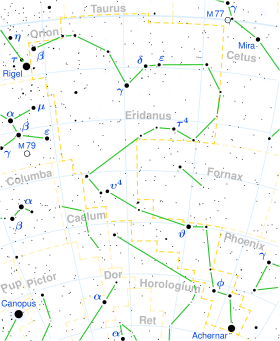Gamma Eridani
Gamma Eridani (γ Eridani, abbreviated Gamma Eri, γ Eri), formally named Zaurak /ˈzɔːræk/,[9][10] is a variable star in the constellation of Eridanus. It is visible to the naked eye with an apparent visual magnitude that varies around 2.9, and lies at a distance of about 203 light years from the Sun, as determined by the Hipparcos astrometry satellite. This is an evolved red giant star that is currently on the asymptotic giant branch of the Hertzsprung–Russell diagram.[3]
 | |
| Observation data Epoch J2000.0 Equinox J2000.0 (ICRS) | |
|---|---|
| Constellation | Eridanus |
| Right ascension | 03h 58m 01.76695s[1] |
| Declination | −13° 30′ 30.6698″[1] |
| Apparent magnitude (V) | 2.88 - 2.96[2] |
| Characteristics | |
| Evolutionary stage | asymptotic giant branch[3] |
| Spectral type | M0III-IIIb[4] |
| U−B color index | +1.96[5] |
| B−V color index | +1.58[5] |
| Variable type | Lb?[2] |
| Astrometry | |
| Radial velocity (Rv) | 60.81±0.25[6] km/s |
| Proper motion (μ) | RA: +61.57[1] mas/yr Dec.: −113.11[1] mas/yr |
| Parallax (π) | 16.04 ± 0.58[1] mas |
| Distance | 203 ± 7 ly (62 ± 2 pc) |
| Absolute magnitude (MV) | −1.19[7] |
| Details | |
| Radius | 80[6] R☉ |
| Luminosity | 1,259[6] L☉ |
| Surface gravity (log g) | 1.0[6] cgs |
| Temperature | 3,811[6] K |
| Rotational velocity (v sin i) | 3.8[6] km/s |
| Other designations | |
Zaurac, Gamma Eridani, Gamma Eri, γ Eridani, γ Eri, 34 Eridani, 34 Eri, HD 25025, HIP 18543, HR 1231.[8] | |
| Database references | |
| SIMBAD | data |
Nomenclature
Gamma Eridani is the star's Bayer designation. It has the traditional name Zaurak, alternatively spelled Zaurac, which is Arabic for 'boat'.[11] In 2016, the International Astronomical Union organized a Working Group on Star Names (WGSN)[12] to catalog and standardize proper names for stars. The WGSN's first bulletin of July 2016[13] included a table of the first two batches of names approved by the WGSN; which included Zaurak for this star.
In Chinese, 天苑 (Tiān Yuàn), meaning Celestial Meadows, refers to an asterism consisting of γ Eridani, δ Eridani, π Eridani, ε Eridani, ζ Eridani, η Eridani, π Ceti, τ1 Eridani, τ2 Eridani, τ3 Eridani, τ4 Eridani, τ5 Eridani, τ6 Eridani, τ7 Eridani, τ8 Eridani and τ9 Eridani.[14] Consequently, the Chinese name for γ Eridani itself is 天苑一 (Tiān Yuàn yī, English: the First [Star] of Celestial Meadows.)[15]
USS Zaurak (AK-117) was a United States Navy Crater class cargo ship named after the star.
References
- van Leeuwen, F. (2007), "Validation of the new Hipparcos reduction", Astronomy and Astrophysics, 474 (2): 653–664, arXiv:0708.1752, Bibcode:2007A&A...474..653V, doi:10.1051/0004-6361:20078357.
- Samus, N. N.; Durlevich, O. V.; et al. (2007), Combined General Catalogue of Variable Stars (GCVS4.2), retrieved 2016-09-30. VizieR On-line Data Catalog: B/gcvs.
- Eggen, O. J. (1992), "Asymptotic giant branch stars near the sun", The Astronomical Journal, 104: 275, Bibcode:1992AJ....104..275E, doi:10.1086/116239.
- Keenan, P.; McNeil, R. (October 1989), "The Perkins catalog of revised MK types for the cooler stars", Astrophysical Journal Supplement Series, 71: 245–266, Bibcode:1989ApJS...71..245K, doi:10.1086/191373.
- Mermilliod, J.-C. (1986), Compilation of Eggen's UBV data, transformed to UBV (unpublished), SIMBAD, Bibcode:1986EgUBV........0M.
- Massarotti, Alessandro; et al. (January 2008), "Rotational and radial velocities for a sample of 761 HIPPARCOS giants and the role of binarity", The Astronomical Journal, 135 (1): 209–231, Bibcode:2008AJ....135..209M, doi:10.1088/0004-6256/135/1/209.
- Cardini, D. (January 2005), "Mg II chromospheric radiative loss rates in cool active and quiet stars", Astronomy and Astrophysics, 430: 303–311, arXiv:astro-ph/0409683, Bibcode:2005A&A...430..303C, doi:10.1051/0004-6361:20041440.
- "* gam Eri". SIMBAD. Centre de données astronomiques de Strasbourg. Retrieved 2016-10-09.
- Kunitzsch, Paul; Smart, Tim (2006). A Dictionary of Modern star Names: A Short Guide to 254 Star Names and Their Derivations (2nd rev. ed.). Cambridge, Massachusetts: Sky Pub. ISBN 978-1-931559-44-7.
- "IAU Catalog of Star Names". Retrieved 28 July 2016.
- Allen, R. H. (1963), Star Names, Dover, p. 218, retrieved 2016-10-09.
- IAU Working Group on Star Names (WGSN), IAU, retrieved 2016-05-22
- Bulletin of the IAU Working Group on Star Names, No. 1 (PDF), retrieved 2016-07-28.
- (in Chinese) 中國星座神話, written by 陳久金. Published by 台灣書房出版有限公司, 2005, ISBN 978-986-7332-25-7.
- (in Chinese) 香港太空館 - 研究資源 - 亮星中英對照表 Archived August 19, 2010, at the Wayback Machine, Hong Kong Space Museum. Accessed on line November 23, 2010.